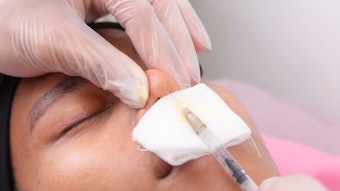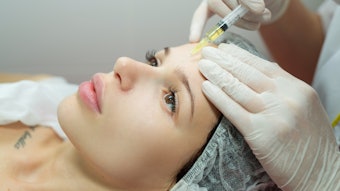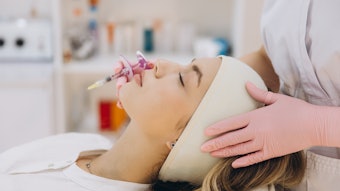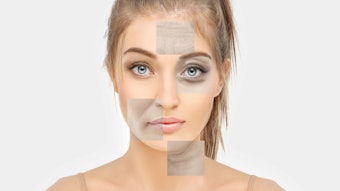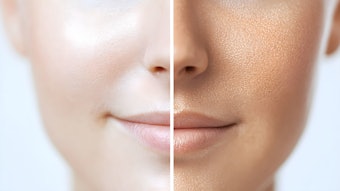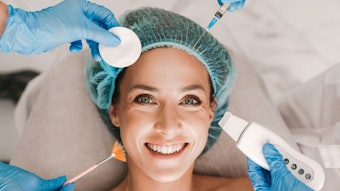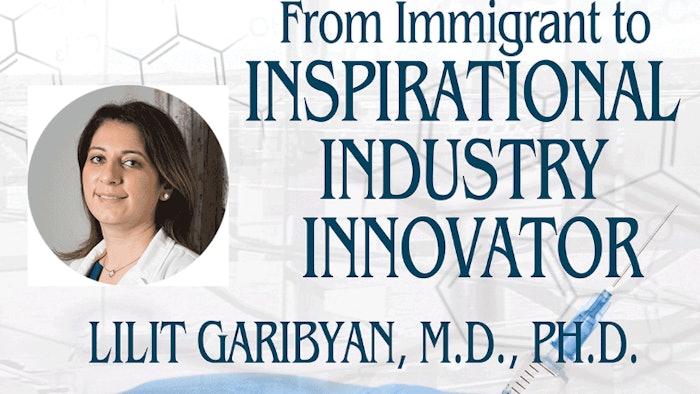
Lilit Garibyan, M.D., Ph.D., Associate Professor of Dermatology at Harvard Medical School and a Physician-Scientist at the Wellman Center for Photomedicine at MGH, spoke of her immigration to the United States from Armenia at 12 years old and determination to help others through medicine as an adult at this year’s ASLMS Celebration of Women in Energy-Based Devices. In her presentation, "From Curiosity to Excellence: A Journey from Immigrant to Innovator," Dr. Garibyan highlighted how the, "power of curiosity, passion and perseverance helped me get through insurmountable odds to become a Harvard-educated and trained physician-scientist, humanitarian, innovator and trailblazer of a new field of injectable cooling."5 This is her incredible story.
A Young Girl’s Dream
In 1991, as the Soviet Union crumbled, a 12-year-old girl named Lilit Garibyan boarded a plane with her family, leaving behind the familiar streets of Yerevan, Armenia. Fearing that her younger brother would be forced into military service amid their nation’s growing war, the family left their home for Glendale, California, home to a large Armenian community, in the United States. Little did young Lilit know that this journey would be the first step towards becoming a groundbreaking scientist and humanitarian.
Overcoming Adversity Through Curiosity
Arriving in America with limited English skills and facing socioeconomic challenges, Dr. Garibyan could have easily been discouraged. She still recalls the disorientation of her first months in America, particularly at school, as she wrestled to learn an entirely new language. What was meant to be a brief stay, turned into years, rife with economic and cultural challenges.
Despite the daunting language barrier and growing up with socioeconomic challenges, Dr. Garibyan chose to persevere and allowed herself to be open to adventure and her curiosity to push her to learn new things and have new experiences, rather than let adversity dim her light. She chose to view these obstacles as opportunities for growth. Dr. Garibyan let every new word she learned, every cultural difference she encountered fuel her curiosity, ultimately finding that her immigrant experience wasn’t a disadvantage, but a unique lens through which she could view the world.
This insatiable curiosity would become the driving force behind her remarkable career. Despite being advise by a high school guidance counselor that her best bet would be to apply for community college, Garibyan applied and was accepted into the University of California, Los Angeles, where she earned her bachelor’s degree in 2001 in Microbiology and Molecular Genetics. It was here that she first dipped her toes into the world of cutting-edge research, spending a monumental summer in 1999 at the University of California at San Francisco lab of Dr. Donald Ganem, a Harvard Medical School alumnus.
Dr. Ganem urged her to then apply to Harvard’s M.D./Ph.D. program. Her exceptional work at UCLA, graduating with departmental, college and Latin honors (summa cum laude), opened doors to Harvard Medical School, where she would go on to earn both her M.D. and Ph.D. in experimental pathology/immunology in 2009.
While not an easy journey, the adversity and challenges Dr. Garibyan faced fueled her curiosity and tenacity to push boundaries and find new and better treatments for patients suffering from debilitating and chronic skin conditions. She completed her dermatology residency at Harvard/MGH Combined Dermatology Residency Program in Boston, MA. After residency, Dr. Garibyan completed postdoctoral fellowship training at the Wellman Center for Photomedicine under the expert guidance of Dr. Rox Anderson.6
Beyond the Lab: Magic Wand Initiative & Face of Angel
Dr. Garibyan’s impact extends far beyond her impressive scientific innovations. After her residency in dermatology, it was a chance encounter with a high school friend working as a fellow with Dr. Anderson at MGH’s Wellman Center that led her to begin working with him. Excited by the idea of conducting translational research that could directly impact patients’ lives, Garibyan joined Dr. Anderson’s lab, a decision that would prove pivotal to her path and career choices in the years to come.
Dr. Anderson and Dr. Garibyan later joined forces, both faculty at Harvard Medical School and Massachusetts General Hospital in Boston, to create the Magic Wand Initiative (MWI). "As physician-scientists, they share a deep passion for improving patients’ lives with innovative solutions. Dr. Garibyan is the co-founder and the Director of the Magic Wand Initiative and the "Virtual Magic Wand" programs, which teach the process of innovation to clinicians. These internationally-recognized programs empower, engage, and teach healthcare professionals on how to identify unmet needs and collaborate to identify and implement solutions to problems."4
In 2013, she founded Face of Angel, a non-profit organization dedicated to improving dermatological care in Armenia. She has dedicated significant efforts to her non-profit, which works to improve the standard of care and bring current laser devices and treatments to people in Armenia that need it for life-altering chronic skin diseases as well as burn scars from laser treatments with old equipment. "I never forgot where I came from," Dr. Garibyan says. "Face of Angel is my way of giving back to the country that shaped my early years."
The Armenia program grew out of Anderson’s earlier efforts in Vietnam, where he and colleagues performed laser surgery for the same vascular problems as in the Armenia program. Dr. Garibyan met an Armenian plastic surgeon who was visiting Boston University and who’d spent some time at Anderson’s lab. After seeing their work, he urged them to bring their expertise with laser surgery for vascular abnormalities to Armenia.7
"Rox said, ‘OK, let’s go,’" Dr. Garibyan said. "I was like, ‘What? I have to ask my boss.’ He said, ‘I am your boss.’ So I said, ‘Yes, we should go.’"
One condition, in particular, that was highlighted by their work in Armenia was port wine stains and the severe lack of adequate treatment for the condition. Failure to treat this condition can lead to serious complications, including blindness, cognitive issues or bleeding and functional challenges in affected body parts, especially the hand and foot. However, according to Dr. Garibyan, the most common and, frequently, the most debilitating effects on patient quality of life are often psychological.
"The psychological impact is huge," said Dr. Garibyan. "Kids don’t want to go outside. They don’t want to interact with others as they feel embarrassed. They’re ostracized because they appear different from others."
These barriers to treatment are what Dr. Garibyan, Face of Angel and the Magic Wand Initiative seek to eliminate. The group made their first trip to Armenia in 2013 and have currently donated six lasers. "It was emotional to go back after being away for 22 years, to see the country you came from. I saw my relatives," Dr. Garibyan said. "I hadn’t gone back because I wanted to go back when I could give something back. I didn’t just want to go say, ‘Hi, I’m Lilit. Nice to see you again.’"
"The first day we saw over 70 consultations. There were so many people wanting to be seen for scars and vascular anomalies," Dr. Garibyan said. "We had to use our creativity and imagination. We were only given the dentist’s room to work out of, so we divided the room into three sections: pre-op, treatment, and post-op."
Since its inception, the organization has made significant strides, including:
- Donated six state-of-the-art lasers to Armenian hospitals
- Trained local doctors in advanced dermatological techniques
- Treated hundreds of patients with chronic skin conditions and burn scars
"I was really happy because I had now created something where I could meaningfully give back," said Dr. Garibyan. "Our work with Face of Angel is a reminder of why I became a doctor in the first place," she shares. "It’s about making a tangible difference in people’s lives, one patient at a time."
Revolutionizing Dermatology: The Birth of Injectable Cooling
Today, Dr. Garibyan serves as an Associate Professor of Dermatology at Harvard Medical School and a Physician-Scientist at the Wellman Center for Photomedicine at Massachusetts General Hospital. But her most exciting work lies in a field she pioneered herself: injectable cooling.
Her incredible strength and perseverance led Dr. Garibyan to take an unintended side effect of coolsculpting technology, which was long-lasting loss of sensation, and see the other possibilities this "problem" presented to improve treatment in another area. Realizing the opportunity to take this element of one technology and use it as a treatment for pain, Dr. Garibyan developed an injectable ice-slurry that can be used to provide targeted and long-lasting pain relief, thus creating an entirely new field of injectable cooling.
"It all started with an unintended side effect," Dr. Garibyan explains. When she examined this accidental side effect after coolsculpting treatment, she noticed an interesting phenomenon. "What others saw as a problem, I saw as potential. I asked myself: could we use this cooling effect to treat pain?"
She spent years understanding the mechanism of this side effect which is what led to the invention and development of injectable cooling technology. The injectable coolant has the ability to reduce pain by numbing nerves without using the extreme cold typically used in cryotherapy, thus providing targeted, long-lasting pain relief.
According to one clinical study, "Cutaneous pain is a common symptom of many dermatological and nondermatological diseases. The majority of cutaneous pain is nociceptive pain caused by thermal (such as burns due to heat or radiation), chemical (such as toxins) and inflammatory processes. Neuropathic skin pain caused by a lesion or disease of the somatosensory nervous system is also frequently seen in patients with postherpetic neuralgia and surgical trauma (to nerves and tissue around the surgical site)."1
This new injectable coolant will revolutionize the treatment of peripheral nerve and cutaneous pain as well as neuropathic skin pain, both of which are significant factors for patients with various skin conditions, as well as for patients experiencing post-procedure pain. To put it lightly, this revolutionary treatment has the potential to transform countless patients’ lives. Dr. Garibyan hopes this groundbreaking pain treatment will reduce or entirely eliminate the need for opioids, thus helping fight the deadly opioid epidemic ravaging the nation and countless lives.
In addition, the injectable coolant can be used to selectively target and reduce fat tissue anywhere in the human body accessible with a needle. This has opened the opportunity of using the injectable coolant to target subcutaneous fat for body contouring in the field of aesthetic dermatology. It has allowed the use of this to target fat at the base of the tongue as a novel treatment for obstructive sleep apnea. In addition, this same coolant can be used to target visceral fat around the abdomen and around heart to treat metabolic and cardiovascular diseases. The promise of this platform technology is boundless and will transform the practice of medicine in many medical fields.
Breakthrough Recognition, Achievements & Impact
In October 2023, Brixton Biosciences, the company working to develop Dr. Garibyan’s innovation, announced that Neural Ice Therapy had received Breakthrough Device Designation from the FDA. This recognition underscores the treatment’s potential to address crucial unmet needs in pain management.2
In pre-clinical studies, animal models have demonstrated the remarkable capability of this treatment to provide relief for three months or more, offering a simple and effective solution to address crucial unmet needs in the field of pain management. In one study, the injectable Neural Ice demonstrated the ability for targeted treatments through "tissue selectivity for peripheral nerves in a rat sciatic nerve model,"3 and another study demonstrated that this selective cryoneurolysis using Neural Ice provided "long-lasting, reduced mechanical pain sensitivity in a rat sciatic nerve model."1
Dr. Garibyan’s groundbreaking work has not gone unnoticed. Her achievements include:
- Multiple patents filed for her injectable cooling technology for various therapeutic applications
- Numerous research breakthroughs in dermatology and pain management
- Recognition from the scientific community, including the American Society for Laser Medicine and Surgery (ASLMS)
- Millions of dollars in grant funding from NIH and Department of Defense
"Each recognition is a reminder of the power of curiosity and perseverance," Dr. Garibyan reflects. "But the true reward is seeing the impact on patients’ lives."
A Message of Hope & Inspiration
Dr. Garibyan’s journey from a young immigrant to a Harvard educated physician-scientist and innovator is a testament to the power of curiosity, grit and compassion. Her story serves as an inspiration to aspiring scientists, immigrants, and anyone facing seemingly insurmountable odds.
"Embrace your curiosity," Dr. Garibyan advises. "Let it guide you to ask questions, seek answers, and push boundaries. And remember, your unique experiences – even the challenges – can be your greatest strength."
As she continues to pioneer new treatments and touch lives through her humanitarian work, Dr. Garibyan remains true to the words of Albert Einstein: "The important thing is not to stop questioning."
Dr. Lilit Garibyan’s story reminds us that great innovations often come from unexpected places and that with curiosity as our compass and perseverance as our fuel, we can overcome seemingly insurmountable odds and all have the potential to change the world – one innovation, one patient, one act of kindness at a time. Her work in injectable cooling and her humanitarian efforts are changing lives and inspiring the next generation of medical innovators.
REFERENCES:
- Moradi Tuchayi, Sara et al.Cryoneurolysis with Injectable Ice Slurry Modulates Mechanical Skin Pain, Journal of Investigative Dermatology, Volume 143, Issue 1, 134 - 141.e1
- Press Release: Brixton Biosciences' Neural Ice™ Therapy granted Breakthrough Device designation by the FDA, CAMBRIDGE, Massachusetts, Oct. 25, 2023
- Garibyan L, Moradi Tuchayi S, Wang Y, Khodorova A, Stemmer-Rachamimov A, Purschke M, Osseiran S, Evans CL, Mao J, Strichartz G, Anderson RR. Neural Selective Cryoneurolysis with Ice Slurry Injection in a Rat Model. Anesthesiology. 2020 Jul;133(1):185-194. doi: 10.1097/ALN.0000000000003124. PMID: 31977524; PMCID: PMC7299828.
- http://www.magicwandinitiative.org/
- https://www.aslms.org/annual-conference-2024/for-attendees/program/special-speakers
- https://wellman.massgeneral.org/faculty-anderson-pi.htm
- MGH Wellman Center physicians bring treatment to Armenia — Harvard Gazette
UPDATE: Certain innaccuracies contained in the original version of this article have been amended.



